|
HTML File Size: 132k Loading ...(3rd draft 16.05.2011)
Introduction
Over the years, I had always held a strong belief among all the camera manufacturers,
Nikon simply made the most efficient automatic film advance devices for their SLR
system. I remember those days which began with the 4fps F36 Motor Drive for Nikon F (1959) where motor drive which
supposedly as as optional accessory had been slowly transformed into full system
to cater for many extensions of application such as remote, timer and high speed
photography (an example is the 9 fps Nikon F High Speed); and during the Nikon F2 (1970) the device had been
improved further and when combining with other accessories, it had opened up plenty
of other photographic opportunities never been realized before in 35mm SLR photography;
and it also has the most extensive motor drives offered for the camera with the initial
model MD-1, an impressive 5 fps MD-2, a moderately price MD-3 and the special MD100 designed to work with
the 14 fps Nikon F2H (high Speed). However, when
Nikon F3 was unveiled in 1980, Nikon
had only designed a single model, 6 fps MD4 for the F3 and it was the only* motor drive that supported
the entire generation of their professional Nikon F3-series. But the mighty MD-4
was simply an engineering and electrical marvel in setting a standard in power efficiency
management for electric motor drive where only a set of 8 x AA-size Alkaline cells,
the MD4 can deliver 140 rolls of 36 exposures; while a comparing Canon New F1's professional AE
Motor Drive FN can only delivers approx. 50 rolls with 12 AA-size Alkaline; truly
an amazing feat huh ?
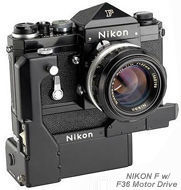 |
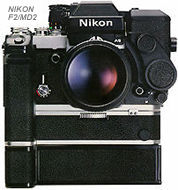 |
 |
* another model, the Nikon MD-4H was introduced
only late in 1996 to supplement the 13.5 fps Nikon F3 High Speed. Other devices: AW-1 Winder for Nikkormat/Nikomat
series; evergreen MD11/MD12 for midrange Nikon SLRs (such as NIKON FM, FE, FE2, FM2, FM2n, FM2n/T and works even on the FA & Nikon FM3A); MD-15
for Nikon FA
and MD-E
power winder for Nikon EM/FG/FG2.From the Nikon F501 onwards, integrated motor for
automatic film advance had replaced conventional add-on accessory.
|
So, it is always interesting to track back n time to understand the different development
stages how Nikon started in making electric motor for automatic film advance for
their cameras. It all began from the rangefinder era, where the S36 was first designed
in the mid of the '50 to add as an optional accessory for the Nikon rangefinder system. |
Basic information
on Nippon Kogaku Japan S36
Electric Motor Drive.
Year Introduced: 1956; Discontinued: early '60
 |
Even as an optional
accessory, Nikon S36
motor drive had directly created an important milestone in 35mm photography as it
offered a new dimension to challenge conventional camera handling in 35mm photography.
Today, virtually all modern SLRs have an integrated motor built-in for the ease of
capturing images readily without performing manual film advance. The S36 can also
be regarded as the first mass-produced electrically charged device designed for automatic
film advancing for 35mm photograpy, as available models in the market equivalent
in function appeared during the corresponding period were mostly based on mechanical
spring-winding principle (such as the Leica-Motor (MOOLY).
<<<--- Probably the first
motorized 35mm camera, a huge-sized LEICA 250 GG Motor, this particular set hold
the record as the most expensive Leica 250 GG w/Motor ever auctioned successfully @
EURO 108,155/USD130,000 !
|
|
| |
|
 |
With its inclusion,
it also formed as one of the basis why the NIKON SP rangefinder system can be regarded
as the best system camera available during that era. It was aimed to supplement the
Nikon RF camera as part of a truly functional system accessory, together with other
creative functions, as well as backed with a whole new series of exciting Nikkor
lenses appearing during this period as its backbone; Nikon rangefinder system had
finally firmly stamped its mark to claim as a serious system of choice for considering
as a personal 35mm rangefinder system for many individual as well as professionals
worldwide.
Today, even after more than half
a century later, the Nikon S36 Electric Motor has remained as one of the most desirable
collector item for camera enthusiasts worldwide. Other than sentimental reasons,
I guess other than awaiting its appreciation in value as form of investment, probably
most collectors also appreciate the creative thought behind in its creation, engineering
excellence as well as registering history how it had changed the course in camera
making industry.
<<<--- a NIKON SP chrome
w/Nikkor-N.C 1:1 f=5cm and S36 electric motor drive.
|
| |
|
In relating to
development of the S36 in Nikon, one of the best info source was compiled by Robert
Rotoloni in his book, Nikon
Rangefinder camera
(Hover Collector's Book, UK) where the author had itemized a version history (seven
stages) in the differences appeared during the period. Regardless in the details,
Nikon S36 was officially announced after the SP, I think most of us must understand
the S36 electric motor was first of its kind in its attempt, naturally there bound
to be modifications and/or improvement made during its initial stages, even after
its launch. This is usual, as it happened with the initial MD-11 for the compact
Nikon as well as the first model, MD1 for the Nikon F2, but eventually both next
update of MD12 and MD2 motor drives had proved to be extremely reliable. In particularly,
the 1979's MD12 is an evergreen model, survives itself all the way be used to supplement
the hybrid mechanical/electronic Nikon FM3A in 2001 !
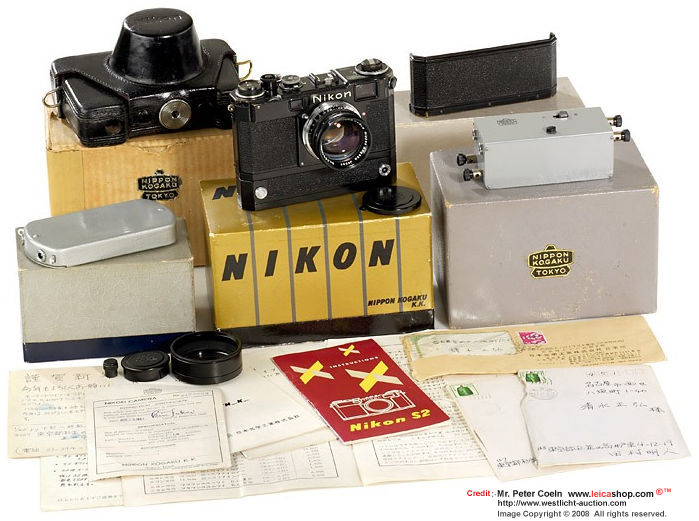 |
Update:-
According to Peter Braczko's Nikon Handbook, it had stated a Nikon S2E which was
shown at IPEX, Chicago back in 1957 and quoted it as a pre-SP with a S36 motor drive
attached for display. He also mentioned a S2E w/S/N 619401x but recently via Leica
Shop's Westlicht Photographica Auction, another complete set of NIKON S2E with an even earlier S/N
6194009 surfaces. Here the auction description quoted it " ..The NIKON
S2-E was the first Nikon with electric motor drive and also the most early 35mm postwar
camera with electric motor drive (already before Leica MP-2). Only 4-5 cameras (out
of 10-15 produced) are known to exist...".
<<<--- take good notice
of the picture at left, as it may show many details of a yesteryear 's original equipment,
accessories and even in their respective packing design/method. This particular set
has an action start price of EURO 90,000-00 and a hammer price of EURO 180,000-00
! |
 |
|
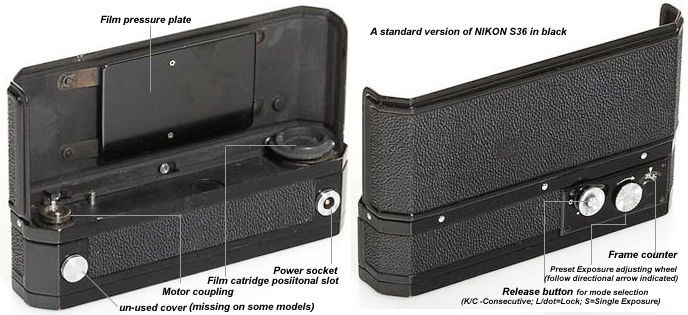 |
Nikon probably
has first designed their system with initial idea of a modular form, with accessories
such as film back can be detached at the bottom to load/unload film but also able
to accept other accessories introduced at later stages. So, in order for the S36
to be used on a SP, S3, S3M and even the S4, you would require to detach the camera
film back as the electric motor has a film back on its own to replace the standard
film back in conventional way in changing a film cartridge. Note: Nikon also produced
cartridge on their own, |
|
 |
| |
|
To operate the
S36 with a capable Nikon rangefinder (SP and later models), turn A-R ring on the
camera's top plate to "A" and advance film, trip the shutter until the
exposure counter at "0", just like conventional way in operating a camera.
Always set the camera ready before connecting the power cord to the battery. The
rear section of the motor drive is the control center, where you find the film counter
which indicates the remaining exposures available in the film cartridge; the Selector
wheel with an arrow indicated the direction is for, if a preset number of exposure
is desired by the user, you can set the counter on the electric motor by first, depressing
while rotating the wheel at the same time with the direction of the arrow indicated.
In this manner, the motor drive will stop automatically at the counter when reaches
"0". For instance, if the entire roll of film is to be fired in one burst,
set the counter at 36, if only 10 frames are to be fired in one go, just set the
counter at 10 etc. Take note:, if the counter happens to set by mistake at 36 exposures,
but the film actually loaded makes 20 exposures, take caution not to keep depressing
the shutter button after 20 exposures have been made. It auto shuts for further film
advance based on user's set exposures. Otherwise, the film end or its perforations
may be torn and rewinding will become difficult. The S36 doesn't has a power rewind
feature, you ought to make manual film rewinding.
 |
1) Singe Exposure:
For S36 late models, first set the S/L//C ring at the rear section by pushing it
inward and turn to "S" (which universally simply means "Single Frame",
L=Locked; C/K means Continuous or Consecutive exposures Mode). The S/C ring may just
has C/L or K/L, depends on version and stages introduced (also refer to S2E/S36 photo
above). Any shutter speeds, EXCEPT for T (Time exposure) and B (Bulb) can be used.
Take note here that at slower shutter speed selected, such as 1/2 or 1 sec exposure
one single exposure mode, the user has to keep depressing the shutter release button
until it has completed an exposure because the motor may go to next frame as soon
as you release the finger. This is something just like what we do with flow sync
flash in modern cameras. The camera shutter release button as well as the power pack
and/or relay box is usable.
|
2) Continuous Mode: A highest speed in film advance rate is approx. 3 fps. It enables
any number of exposures of sequence photos to be taken and automatically stops at
preset exposures. The same is apply to how to operate the S36, user must ensure an
exposure is made until the next frame but since this is continuous so less chances
in making such mistake. It is advisable if the remaining exposures in the film is
completed, detach the power cord from the camera first. The S36 doesn't has the firing
rate selector wheel as found on the F36 Motor Drive for Nikon F. It is not possible
to make double or multiple exposures in C mode, a lovely creative feature like the
one as found on the MD12/MD4 offers.
Presumably the S36 was for SP but if the owner wishes to use it with other camera
model, Nikon advised changes should be done with an authorized Nikon technician or
any service centre where a nominal fee is applicable. The same go for the F36 for
NIKON F, where Nikon stated the F36 was factory fitted for particular F or other
F-Photomic body and may not function when it is used with other model. |
| |
|
 |
The S35 was supplied
either in chrome or black finish to match individual desire for their choices as
the Nikon SP has both.
|
| The S36 doesn't
has a built-in battery compartment and would require an external battery pack. Robert
Rotoloni had suggested prior to the more popular brown leather cased battery holder
version, it may has an earlier version. The leather cased batter holder is quite
cumbersome to carry around with as it is shown in proportion with the picture below
with the S36. Somehow, it restricts mobility of the photographer but or the next
design, "Vest Pocket Battery Case, as Nikon called it) is more portable,
it is flat and connects the device onto camera via a metre-long power cord. You can treat S36's external power pack as an off-camera
remote control device because the battery holder has a release and yes, you can
trip the shutter from the power pack one metre away from the camera too. Power source changed
along with either in design along with the battery holder version where initial model
uses 6 x 1.5 volts type-C penlight size cells such as old type Eveready 815, Mallory
Zinc penlight cells or modern equivalent. The cells drop in and stag on one another
which contributed to the oblong design while the next version, a sardine gray colored,
vinyl texture holds the batteries flat side by side and enables a more compact size
in its design. |
|
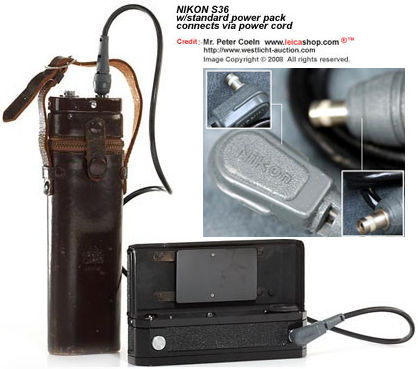 |
Nikon had even
designed a power voltage meter to provide visual check on the power voltage as the
electric motor would not function normally or decrease in operating speed when current
drops under 8.5 volts (if other third party power supply is used, Nikon had suggested
electromotive force be: DC. 9 volts and stable electric current : 0.4 amperes) .
A relay box was also offered at late '59 which can be used among the S36, F36 and/or
the 250 electric motor drives. Note: F36 uses 12v, below 10v will cause deterioration
of function or does not operate at all.
| left &
bottom: early brown leather battery case and highly portable Sardine /gray vinyl
texture battery pack, the supplied power cord has dedicated connecting pins at each
end, while the gray version may be replaceable with some specific commercial connecting
cord but MUST be 3-core type
. Voltage meter is for checking power output of new cells or check status of old
cells in the power pack. |
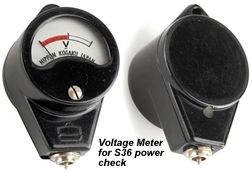 |
|
 |
 |
Used in conjunction with a Standard Battery
Pack, permits a Nikon camera equipped with either S36, F36 or F250 motor drive to
be operated through a conventional 2-conductor cord, terminating in any circuit closing
device: manual switch, intervalometer, radio control receiver, or others. Meaning,
it connects between motor drive unit and the battery pack, and can be used conveniently
for long distance remote control, in the case of later Nikon accessories with the
SLR period, it can be used together with a timer, intervalometer, wireless operation
as well as simultaneously trigger firing of several Nikon cameras at the same time,
However, in the case of S36, available options were restricted, as many wireless
accessories were not readily available during that time.
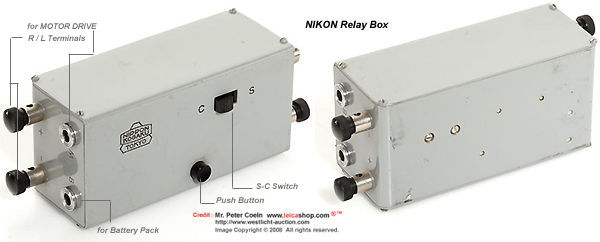 |
The left hand side of the box has four a) power-supply
terminal to the motor ( "M"), b) power-input terminal from the battery
pack ("B"), c/d) DC input terminals "+" and "-". The
two terminals, R1 and R2, can connected by a cords. The S/C switch and a shutter
tripping button is also provided that can override the one on the back of the S36/F36/F250.
The R1/ R2 are for setting up multiple cameras firing at the same time. This Relay
Box is also with the Nikon F.
|
|
One way or another, some people may feel
the cord-connecting S36 restrict mobility of photographer, and cordless model was
only made available in the F36 for Nikon F at later stage. But there was third party
option such as this jpi POWERCON model 36SP power pack designed by Jacobson Photographic
Instrument, vine street, Hollywood, California which eliminates such inconvenience.
jpi Powercon Integral
Power Pack for Nikon S36
 |
Naturally regardless integrated or not, it adds weight
to the camera like the external power pack does and the only difference is whether
the combined weight is integrated on single unit (camera/integral power pack) or
distributed via external pack that is all. I am not sure if there were any other
makers who produced integral power pack like the jpi Powercon console for the Nikon.
|
 |

 |
Basic Specification for Nikon (Nippon
Kogaku K.K.) S36 Electric Motor Drive:-
Type:
Battery powered motor drive unit with integral film back for Single and multiple
sequence exposures w/power connector jack (front and film back open/close lever,
ASA dial and tripod socket at the base. Available in chrome or black finishing
Operation: Activated via shutter release button on camera, power pack or relay
box. Auto stop at end of film set on counter; Selector lever for Single exposure,
consecutive exposures and lock mechanism ; user's preset exposures provided with
frames counter; not advisable on T and B setting.
Operating Voltage: 9v
Power Source: 1) Via external power pack 6 x 1.5v Type C; 2) compact portable
pack
Dimension/Weight: S36 Motor Drive only: no info; Power Pack: no info
<<<--- Shown
here in the Japanese edition NIKON S-Magazine with S36 motor drive in chrome without
the unused cover at the bottom right section
|

Nikon S250 and S72 Electric
Motor Drive Units
The
NIKON S250 Electric Motor Drive shares many similarities such as in its appearance,
dimension, features with the F250 Bulk Film Back designed for the NIKON F introduced
a few years later in 1959. The obvious missing part is the shooting speed selector
dial at the rear section as found in the F36. Bulk film requires other accessories
such as Bulk Film Loader and others. Possibly due to its limited applications which
may associate with professional use in news, sports, scientific research etc. , hence,
possibly not many of these were being made. Further, rangefinder photography is not
as convenient as in single lens reflex's advantage offers in direct viewing through
the lens even with change of lenses, such as one would imagine it can be quite tedious
using reflex housing for long tele-lenses. Anyway, perhaps the limited production
of this special accessory had made the S250 such a scarce item to locate today for
collectors.
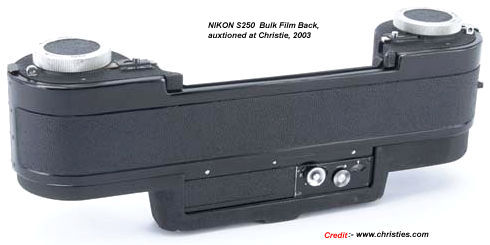
Believe it or
not, prior to the excellent pictures shown below, here is a rare glimpse of a NIKON
S250 Motor Drive w/Bulk Film Back auctioned back in 2003 by Christie Auction House
(www.christie.com) and this was the only photo
you find from the Internet on the S250 ! .... |
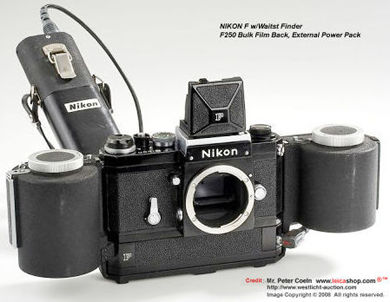 |
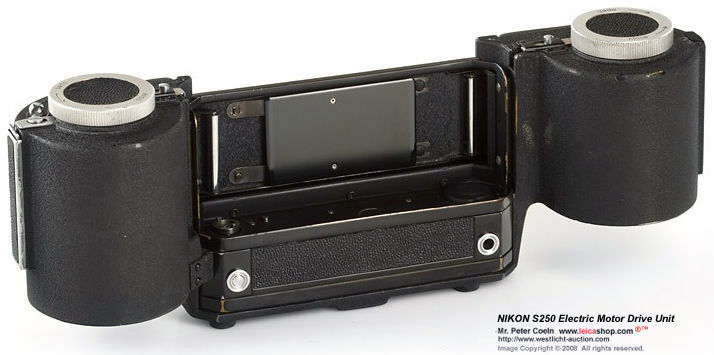 |
Gorgeous ..isn't
it ? perhaps, these few pictures of the NIKON S250 recently auctioned by weslicht
auction can be regarded as the most detailed that you can find on the Internet today.
Take note of the early K.L mode control selection dial found at the S250 rear control
panel. The "K" here means continuous and was replaced with a more relative,
universal alphabet, "C" later. Funny ..
|
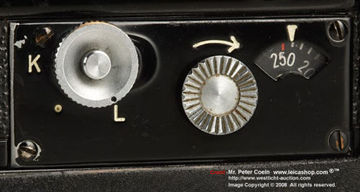 |
Nikon S-250 Electric Motor Drive,
.1959" .... One of two known prototype S-250 motor drives for Nikon RF, the
motor appeared for its first time at Christies auction in November 2003 and was bought
by the famous Japanese collector Tad Sato, it is in excellent and fully original
condition. A fully description with photographs is found in Robert Rotoloni 'The
Complete Nikon Rangefinder System' page 436-440
Indicative pricing (2011) : - EUR 15.000 (Start price) / EUR 28.800 (Hammer price
incl. premium)..." - Westlicht Photographica Auction
|
|
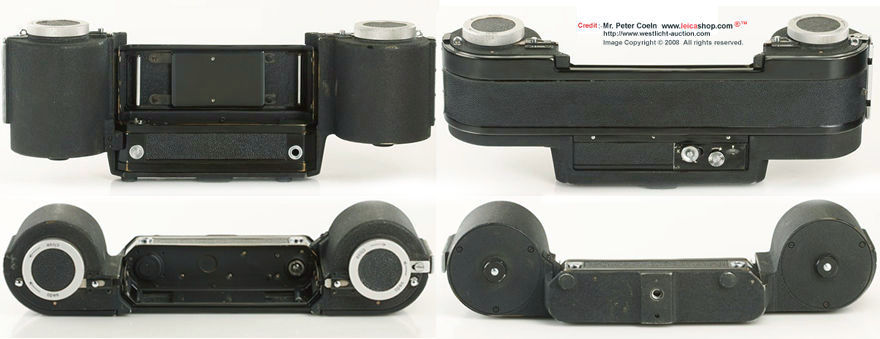 |

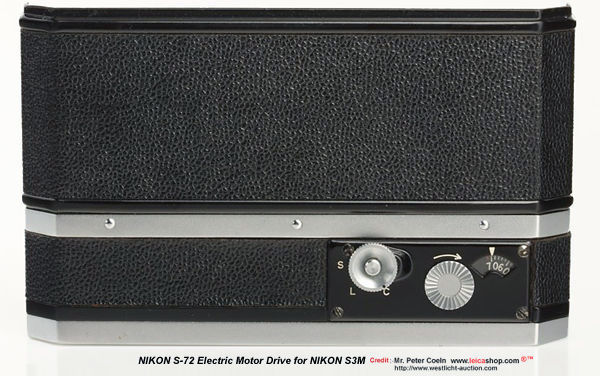 |
NIKON S72
Motor Drive for NIKON S3M
If you think the S250 was rare and less applicable for day to day photography,
in the eyes of many Nikon collectors may think the half frame-specific NIKON S72
built specially for the Nikon S3M could be even more appealing. Although the S3M
was available in black but S72 could have been only being manufactured in chrome
trim version only. It is not cheap in today's collector's market, if you can find
one, where a reasonably good condition S72 could easily fetch similar price like
the equally scarce S250. Power source options are similar to S36.
|
 |
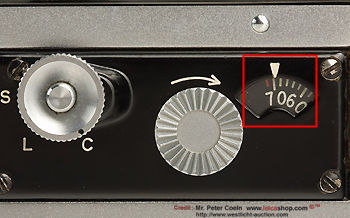 |
Due to the nature
of half frame, the S72 motor drive was specifically to be used for NIKON S3M only.
Because it has less traveling space in horizontal travel shutter curtain, hence,
it can deliver higher shooting rate than a conventional 24 x 36 Nikon S36. According
to some reading references, up to 4.5 fps is possible in this combination. Another
difference is the frame/exposure counter, which provides 72 frames instead of 36
(36 x 2 =72). Unless there are other things that I am not aware of, the rest of other
major control features should be identical with the full frame S36.
|
|
 |
I am not a hero
and wouldn't like to pretend I am one as I
AM JUST AN INFO COMPILER ON THINGS THAT INTEREST ME AS WELL AS FOR ALL TO SHARE
COMMON RESOURCES,
So, if any of you have some good content and/or Manual on the NIKON S36/S72/350 (with
proper reference and permission to use), you can send to my web buddy, Rick and I
will post them here with credit given. Further, if there are any mistakes made in
this site , you may also help to rectify them so as to ensure accuracy of info being
relayed to public CONTACT
my long time web buddy:
rick_oleson@yahoo.com
I do have an Instruction Manual for the NIKON S3M in MIR site, but unfortunately, only in Japanese.
I also had bought a digitized copy each of the Instruction Manual of F36/F250 from
Jean-Louis Beek
for me to confirm some info with the S36/S250 here; so unless you are absolutely
broke you can ask me for a copy, or else you should spare USD5-00 for his good effort
in scanning the manual, hehe ...
|
 |
The corresponding bright line frame inside the finder
with 35mm, 50mm and 105mm changes accordingly with the S3M.
|
|

| Back | to Main Index Page
| Back |
- System Accessories Index or S36 Manual (not complete)
Related info:- Leica/Leitz | Contax/Carl Zeiss | Seiki Kogaku (Canon)
RELATIVE:- Nikon Rangefinder (RF) Models | Pictorial History of Nikon
A small visual library on
Nikon Ultra-Micro-Nikkor lenses
Manual Focus Nikkor lenses | Autofocus
Nikkor lenses
|
| Message
Board
|
lenses
| Message
Board
|
Rangefinder
cameras
System Accessories
for Nikon Rangefinder cameras
Optical Finders (4 parts):- Fixed Focal length Finders (index page): 2.1cm,
2.5cm, 2.8cm,
3.5cm, 35cm Stereo,
5cm, 8.5cm, 10.5cm,
13.5cm | Variframe / Varifocal
/ Sport-frames | Nikon Reflex Housing
Nikon S36/S72/S250 Motor
Drives / S36 Manual
| light meters | Nikon RF Flash/Speedlights | Close-up
photography | Cases/Compartments | Lens & body caps,
Lens Hoods/shades, Original Price Lists
| packaging/boxes
Instruction Manuals
W-Nikkor-O 1:4
f=2.1cm | W-Nikkor.C 1:4 f=2.5cm | W-Nikkor.C
1:3.5 f= 2.8cm | W-Nikkor.C 3.5cm lens Group (3.5/2.5/1.8) | Stereo-Nikkor 1:3.5 f=3.5cm | 5cm (50mm) lens group | RF Micro-Nikkor
1:3.5 f=5cm | Nikkor-P.C
1:2 f=8.5cm lens group / Nikkor-S.C 1:1.5 f=8.5cm lens group | Nikkor-P.C
1:2.5 f=10.5cm lens group
/ Nikkor-T 1:4 f=10.5cm | 13.5cm lens group
| Nikkor-H 1:2.5
f=18cm | Nikkor-Q 1:4 f=25cm
| Nikkor-T 1:4.5 f=35cm | Nikkor-T.C 1:5 f=50cm | External Link:- 100cm f/6.3
|

Back to - Nikon RF-Nikkor lenses
(Rangefinder):- Main Index Page
Nikon
Auto
Focus
Nikkor lenses:- Main Index Page
Nikon Manual
Focus
Nikkor lenses:- Main Index Page
| Back | Main Index Page of Pictorial
History of Nikon SLRs
about this photographic
web site
 |
Home - Photography in Malaysia
|

Credit:- Special thanks to all the contributors of images
and content which made up the basis of the site. Note:certain content and
images appeared in this site were either scanned from official marketing leaflets,
brochures, sales manuals or publications published by Nikon over the years and/or
contribution from surfers who claimed originality of their work for educational purposes.
The creator of the site will not be responsible for may discrepancies arise from
such dispute except rectifying them after verification."Nikon",
"Nikkormat", "Nippon Kokagu KK" & "Nikkor"
are registered trade name of Nikon Corporation Inc., Japan. Site made with an Apple
G5 IMac.
|